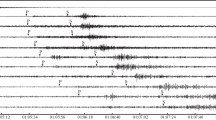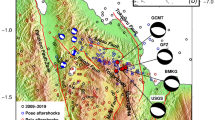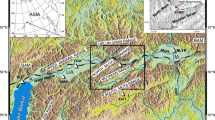Abstract
The article presents the results of studying the source of the 2015 Kenekesir earthquake and its aftershock sequence. The earthquake occurred in the Archman–Nokhur tectonic node zone, where the northwest orientation of the Central Kopet Dag faults changes to the northeast orientation of the Western Kopet Dag faults. The actual rupture plane at the Kenekesir earthquake was determined from the dataset of the focal mechanism, three-dimensional orientation of the aftershock cluster, orientation of the nearest faults, and first isoseismals of previous earthquakes. The rupture plane strikes southwest and dips to the northwest. The displacement type is oblique slip with equal normal-fault and left-lateral strike-slip components. The aftershock series lasted 186 days and consisted of 1249 aftershocks of the representative level (KR ≥ 5.6). At its initial stage, the 11-day period of regular development of the aftershock process is identified, when the Omori law is fulfilled with the highest correlation coefficient and aftershock attenuation parameter p = 1.35. Then, the aftershock process assumes a pulsating character, passing to the stage of stress relaxation in the medium. Accelerograms and velocigrams of the Kenekesir earthquake and its aftershocks are of undoubted interest for assessing the seismic hazard in this area. It was found that the instrumental intensities determined from the velocity (IPGV) and seismic wave power (IPGA ⋅ PGV) agree the best with the regional macroseismic field equation.















Similar content being viewed by others
REFERENCES
Annaorazova, T.A., Golinskii, G.L., Rakhimov, A.R., and Smirnova, N.P., Earthquakes of Kopetdag, Zemletryaseniya v SSSR v 1984 godu (Earthquakes in SSSR in 1984), Moscow: Nauka, 1987, pp. 44–51.
Aptikaev, F.F., Instrumental’naya shkala seismicheskoi intensivnosti (Instrumental Scale of Seismic Intensity), Moscow: Nauka i Obrazovanie, 2012.
Aref’ev, S.S., Foreshocks, aftershocks, and swarms of earthquakes, Izv., Phys. Solid Earth, 2002, vol. 38, no. 1, pp. 55–71.
Aref’ev, S.S., Bykova, V.V., and Vakarchuk, R.N., Model of hypocenter of the September 7, 2009 earthquake in Central Caucasus, Geofiz. Issled., 2011, vol. 12, no. 1, pp. 33–46.
Berberian, M., Historical seismicity (pre 1900) map of Iran. Scale 1 : 5 000 000, Contribution to the Seismotectonics of Iran, Part III. Geological Survey of Iran, Tectonic-Seismotectonic Research Section, 1977.
Chu, D. and Gordon, R.G., Current plate motions across the Red Sea, Geophys. J. Int., 1998, vol. 135, no. 2, pp. 313–328. https://doi.org/10.1046/j.1365-246X.1998.00658.x
DeMets, C., Gordon, R.G., Argus, D.F., and Stein, S., Effect of recent revisions to the geomagnetic reversal time scale on estimates of current plate motions, Geophys. Res. Lett., 1994, vol. 21, no. 20, pp. 2191–2194. https://doi.org/10.1029/94GL02118
Djadkov, P.G. and Mikheeva, A.V., The EEDB – Expert earthquake database for seismic-geodynamic research, Bull. Novosibirsk ICMMG. Math. Mod. Geophys., 2010, no. 13, pp. 15–30.
Emanov, A.F., Emanov, A.A., Filina, A.G., Leskova, E.V., Kolesnikov, Yu.I., and Rudakov, A.D., The common and individual in development of aftershocks of largest earthquakes in the Altai-Sayan mountain region, Fiz. Mezomekh., 2006, vol. 9, no. 1, pp. 33–44.
Fedotov, S.A., Chernyshev, S.D., Chernysheva, G.V., and Vikulin, A.V., Refinement of boundaries of earthquakes with M ≥ 73/4, properties of seismic cycle, and long-term seismic prediction for Kuril–Kamchatka Arc, Vulkanol. Seismol., 1980, no. 6, pp. 52–67.
Gaipov, B.N., Vorontsova, E.S., Golinskii, G.L., Muradov, Ch.M., Petrova, N.V., Rakhimov, A.R., and Abaseev, S.S., National map of seismic zoning of Turkmenistan, Materialy Mezhdunarodnoi Konferentsii, posvyashchennoi 50-letiyu Ashkhabadskogo zemletryaseniya 1948 g (Materials of Int. Conf. Devoted to 50th Anniversary of the 1948 Ashgabat Earthquake), Ashgabat: Ylym, 1948.
Gaipov, B.N., Petrova, N.V., Golinskii, G.L., Rakhimov, A.R., and Saryeva, G.Ch., Kopetdag, Zemletryaseniya Severnoi Evrazii v 2000 godu (Earthquakes of Northern Eurasia in 2000), Moscow: Geophiz. Sluzhba, Ross. Akad. Nauk, 2006, pp. 95–109.
Gardner, J.K. and Knopoff, L., Is the sequence of earthquakes in Southern California, with aftershocks removed, Poissonian?, Bull. Seismol. Soc. Am., 1974, vol. 64, no. 5, pp. 1363–1367. https://doi.org/10.1785/BSSA0640051363
Golinskii, G.L., Equations of macroseismic field of earthquakes in Turkmenia, Izv. Akad. Nauk Turkm. SSR, Ser. Fiz.-Tekh., Khim. Geol. Nauk, 1977, no. 1, pp. 69–74.
Golinskii, G.L., Muradov, Ch.M., and Rakhimov, A.R., The October 16, 1994 Kenekesir earthquake, Zemletryaseniya Severnoi Evrazii v 1994 godu (Earthquakes of Northern Eurasia in 1994), Moscow: Geofiz. Sluzhba, Ross. Akad. Nauk, 2000, pp. 147–151.
Golinskii, G.L., Muradov, Ch.M., and Rakhimov, A.R., The October 21, 1994 Kenekesir earthquake, Zemletryaseniya Severnoi Evrazii v 1994 godu (Earthquakes of Northern Eurasia in 1994), Moscow: Geofiz. Sluzhba, Ross. Akad. Nauk, 2000, pp. 151–163.
GOST R (State Standard) 57546–2017: Earthquakes. Seismic Intensity Scale, 2017.
Guglielmi, A.V., Zavyalov, A.D., and Zotov, O.D., A project for an atlas of aftershocks following large earthquakes, J. Volcanol. Seismol., 2019, vol. 13, no. 6, pp. 415–419. https://doi.org/10.1134/S0742046319060034
Gushchenko, O.I., Mostryukov, A.O., and Petrov, V.A., Structure of the field of modern regional stresses of seismically active zones of Earth’s crust in the eastern part of Mediterranean moving belt, Dokl. Akad. Nauk SSSR, 1990, vol. 312, no. 4, pp. 830–835.
International Seismological Centre. On-Line Bulletin, 2021.
Jackson, J., Priestley, K., Allen, M., and Berberian, M., Active tectonics of the South Caspian Basin, Geophys. J. Int., 2002, vol. 148, no. 2, pp. 214–245. https://doi.org/10.1046/j.1365-246X.2002.01588.x
Kostrov, B.V. and Das, Sh., Principles of Earthquake Source Mechanics, Cambridge: Cambridge Univ. Press, 1988.
Lutikov, A.I., Dontsova, G.Yu., and Rodina, S.N., Time and energetic parameters of the aftershock process for the earthquakes in the Caucasus and adjacent areas, Geofiz. Issled., 2017, vol. 18, no. 1, pp. 20–36. https://doi.org/10.21455/gr2017.1-2
Lykov, V.I., Scheme of tectonic development of Earth’s crust, Otchet Razrabotka Fizicheskoi modeli protsessov v zone ochagov Ashkhabadskikh zemletryasenii (Report on Development of Physical Model of Process in the Hypocenter Zone of Ashgabat Earthquakes), Ashgabat: Inst. Seismologii i Fiziki Atmosfery, 1980, pp. 2–43.
Molchan, G.M. and Dmitrieva, O.E., Identification of aftershocks: Review and new approaches, Vychislit. Seismol., 1991, vol. 24, pp. 19–50.
Molchan, G.M. and Dmitrieva, O.E., Aftershock identification: methods and new approaches, Geophys. J. Int., 1992, vol. 109, no. 3, pp. 501–516. https://doi.org/10.1111/j.1365-246X.1992.tb00113.x
Mostryukov, A.O. and Petrov, V.A., Catalogue of mechanisms of earthquake hypocenters, 1964–1990, Materialy mirovogo tsentra dannykh (Materials of the World Data Center), Moscow, 1994.
Novyi katalog sil’nykh zemletryasenii na territorii SSSR s drevneishikh vremen do 1975 g (New Catalog of Strong Earthquakes on the Soviet Territory from Ancient Times until 1975), Kondorskaya, N.V. and Shebalin, N.V., Eds., Moscow: Nauka, 1977.
Omori, F., On aftershocks, Rep. Imp. Earthquake Invest. Comm., 1894, no. 2, pp. 103–139.
Petrova, N.V., Abaseev, S.C., and Saryeva, G.Ch., Methods of estimating Kmin at registering earthquakes by digital and analog stations of Turkmenistan, Zemletryaseniya Severnoi Evrazii, 2007 g (Earthquakes of Northern Eurasia), Obninsk: Geofiz. Sluzhba, Ross. Akad. Nauk, 2013, pp. 458–467.
Petrova, N.V., Dyagilev, R.A., and Gabsatarova, I.P., Features of seismic impact attenuation of the Russian Platform and Ural earthquakes, Seism. Instrum., 2021, vol. 57, no. 2, pp. 132–149. https://doi.org/10.3103/S0747923921020304
Prozorov, A.G., Dynamic algorithm for extracting the aftershocks for the world catalogue of earthquakes: Mathematical methods in seismology and geodynamics, Vychislit. Seismol., 1986, vol. 19, pp. 48–62.
Radziminovich, N.A. and Ochkovskaya, M.G., Extraction of aftershock and swarm sequences of earthquakes of Baikal Rift Zone, Geodyn. Tektonofiz., 2013, vol. 4, no. 2, pp. 169–186. https://doi.org/10.5800/GT-2013-4-2-0096
Rastsvetaev, L.M., Faults in Central Kopetdag and their relation with folded structure, Geotektonika, 1966, no. 3, pp. 93–107.
Rastsvetaev, L.M., On the role of horizontal stresses in the formation of the modern structure of Kopetdag, Noveishie tektonicheskie dvizheniya i struktura al’piiskogo geosinklinal’nogo poyasa Yugo-Zapada Evrazii (Modern Tectonic Motions and Structure of Alpine Geosynclinal Belt of South-Western Eurasia), Baku: Elm, 1970, pp. 138–144.
Rautian, T.G., Energy of earthquakes, Metody detal’nogo izucheniya seismichnosti (Trudy IFZ AN SSSR, No. 9 (176)) (Methods of Detail Study of Seismicity), Moscow: Inst. Fiz. Zemli Akad. Nauk SSSR, 1960, pp. 75–114.
Rautian, T.G., Khalturin, V.I., Fujita, K., Mackey, K.G., and Kendall, A.D., Origins and methodology of the russian energy K-class system and its relationship to magnitude scales, Seismol. Res. Lett., 2007, vol. 78, no. 6, pp. 579–590. https://doi.org/10.1785/gssrl.78.6.579
Reasenberg, P., Second order moment of central California seismicity, 1969–1982, J. Geophys. Res., 1985, vol. 90, no. B7, pp. 5479–5495. https://doi.org/10.1029/JB090iB07p05479
Riznichenko, Yu.V., Dimensions of hypocenter of crust earthquake and seismic moment, in Issledovaniya po fizike zemletryasenii (Studies on Physics of Earthquakes), Moscow: Nauka, 1976, pp. 9–27.
Saryeva, G.Ch., Petrova, N.V., and Bezmenova, L.V., Kopetdag, Zemletryaseniya Severnoi Evrazii (Earthquakes of Northern Eurasia), No. 22 (2013), Obninsk: Edinaya Geofiz. Sluzhba Ross. Akad. Nauk, 2019, pp. 96–107. https://doi.org/10.35540/1818-6254.2019.22.08
Saryeva, G.Ch., Petrova, N.V., and Bezmenova, L.V., Kopetdag, Zemletryaseniya Severnoi Evrazii (Earthquakes of Northern Eurasia), No. 23 (2014), Obninsk: Edinaya Geofiz. Sluzhba Ross. Akad. Nauk, 2020, pp. 84–94. https://doi.org/10.35540/1818-6254.2020.23.07
Saryeva, G.Ch., Tachov, B., Khallaeva, A.T., Durasova, I.A., Esenova, A., and Petrova, N.V., Catalogue of earthquakes of Kopetdag in 2015, Zemletryaseniya Severnoi Evrazii. Vyp. 24 (2015 g) (Earthquakes of Northern Eurasia, No. 24 (2015)), 2021. http://www.ceme.gsras.ru/ zse/app-24.html.
Shebalin, P.N., Narteau, C., and Baranov, S.V., Earthquake productivity law, Geophys. J. Int., 2020, vol. 222, no. 2, pp. 1264–1269. https://doi.org/10.1093/gji/ggaa252
Tatevossian, R.E. and Aptekman, Zh.Ya., Aftershock sequences of the strongest earthquakes of the world: Stages of development, Izv., Phys. Solid Earth, 2008, vol. 44, no. 12, pp. 945–964.
Ulomov, V.I., The GSHAP Region 7 Working Group, Seismic hazard of Northern Eurasia, Ann. Geophys., 1999, vol. 42, no. 6, pp. 1023–1038. https://doi.org/10.4401/ag-3785
Ulomov, V. and Trifonov, V., Map of lineament-domain model of seismic source zones, SHA – Caucasus test area, 1997. http://static.seismo.ethz.ch/gshap/caucas/caucas. html.
Utsu, T.A., A statistical study on the occurrence of aftershocks, Geophys. Mag., 1961, vol. 30, pp. 521–605.
Zavyalov, A.D. and Zotov, O.D., A new way to determine the characteristic size of the source zone, J. Volcanol. Seismol., 2021, vol. 15, no. 1, pp. 19–25. https://doi.org/10.1134/S0742046321010139
ACKNOWLEDGMENTS
The authors are grateful to the staff of IS&AF AST and its director G.Ch. Saryeva for support and source materials for the study.
Funding
The study was carried out in accordance with state task no. 075-00576-21 of the Ministry of Education and Science of Russia and topic TV 08.00.2526 “Assessment and Prediction of Seismic Hazard in the Territory of Turkmenistan” of the research plan of the Academy of Sciences of Turkmenistan.
Author information
Authors and Affiliations
Corresponding author
Ethics declarations
The authors declare that they have no conflicts of interest.
About this article
Cite this article
Petrova, N.V., Abaseev, S.S. & Bezmenova, L.V. Kenekesir Earthquake of October 12, 2015 (MW = 5.2) in the Western Kopet Dag: Aftershock Series and Strong Ground Motions. Seism. Instr. 58, 63–85 (2022). https://doi.org/10.3103/S0747923922010091
Received:
Revised:
Accepted:
Published:
Issue Date:
DOI: https://doi.org/10.3103/S0747923922010091




